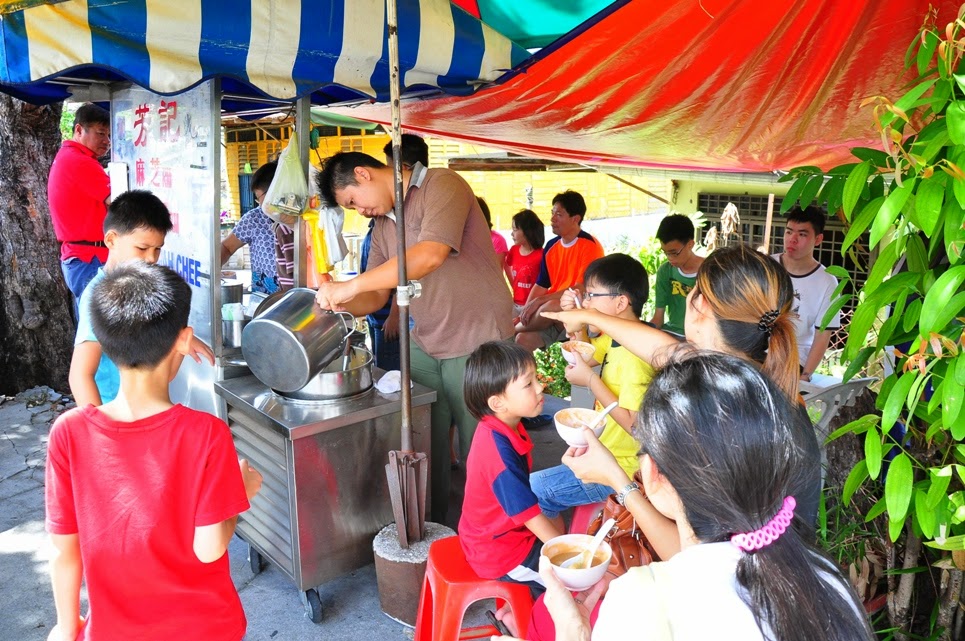Discovering Pasir Pinji's Comfort Food - 29 June 2014
Pasir Pinji Road in Ipoh is like a living heritage town. If you google this place, you will see a long list of local delicacies you must try - the famous yong tau foo, chee cheong fun, cendol, roast pork, traditional mooncakes, pastry, etc. On a Sunday, we saw the idyllic lifestyle of the local people - watching the days go by, sipping tea and catching up with friends along the corridor of shophouses, waiting for the takeaway of their favourite food or desserts from the roadside hawkers, sitting in coffee shops and dipping Hainanese buns into their kopi-O or Milo... it's like a walk to my childhood years in the 80s.
Ban Guan Foong Bakery has been around for more than 50 years. One of the very few remaining bakeries producing traditional Hainanese bread and buns using wood-fired oven.
A family-run business by the Goh family and some old and loyal workers.
Getting ready the wood-fired brick oven
Removing the ashes from the heated oven
Trays of doughs to be loaded into oven
After a while, the whole 'Hah' clan in Ipoh joined us at the bakery. Surprisingly, the bakery staff did not mind the curious visitors that crowded the place to see the process.
Hainanese white bread, coconut buns, kaya buns and plain buns are the favourites. The coconut and kaya fillings are made in-house. They are sold to coffee shops and wholesalers around town.
Putting trays into heated oven.
Baking time is less than 10 minutes.
Getting ready to pack the buns for the waiting customers.
This is the hard-crust bread, only available in limited quantity per day. It resembles the French breads and very tasty and cheap at RM1.70 per loaf. This was the last batch to be baked so we didn't wait for it. A staff from the bakery went round the village to look for us to pass me these - fresh from the oven! Such warm people here.
I do not normally eat coconut buns but this will transport you to the good old days of waiting for the 'rotiman' in his bike full of buns, sweets and snacks. Hainanese breads are pillowy soft, more dense yet airy with the smoky flavour from the brown crusts. Sometimes, we dip into the kopi-O or Milo - full of flavour.
Many of the success stories in food start from humble beginnings under a Big Tree in Pasar Pinji. Another local delicacies here are the 'Hong Kee' peanut paste and mua chee. If I am not mistaken, this is the 3rd generation running the business. It was passed down from their grandfather since 1950s.
The stall is set up just in front of a house, and under a Big Tree. While most people have mechanised their processes, the Lee family is still using the stone grinder to crush the peanut.
An unassuming stall that attracts both the locals as well as tourists.
Can you believe we have 4 families of the 'Hah' clan here!!
I love the creamy and smooth texture of the peanut paste. Though it's expensive (RM2.50) and some locals commented that the standard is different now as compared to the grandfather's time, I still love it. It's really hard to come by a dessert still made in the old fashioned way.
I love the creamy and smooth texture of the peanut paste. Though it's expensive (RM2.50) and some locals commented that the standard is different now as compared to the grandfather's time, I still love it. It's really hard to come by a dessert still made in the old fashioned way.
The boys love the chewy glutinous rice balls - mua chee, also RM2.50 for a small portion. Some people eat the mua chee by dunking it into the peanut paste. We'll definitely come back for more next time!
Another success story under a Big Tree in Pasar Pinji - the Sagu Ice dessert (Sek Lau Zhi). Growing up in KL, I've never ever heard of this dessert. I love cendol ice, and this is like a cousin to cendol. Business was brisk, and we saw many young people queuing for the dessert.
The stall is only open on weekends and public holidays from 1-6pm only. Currently, the daughter Ah Ngan is running it, taking over from the mother who had been selling this dessert since the 70s. I understand there're only one or two stalls in Ipoh selling this dessert.
The red rubies are made from tapioca flour and they're not sago (Sek Lau Zhi), the colourful wriggly strands made from rice flour (like cendol) served with shaved ice concoction, coconut milk and syrup. The stall was swarmed by tiny bees, and it's really amazing to see the locals braving the stinging bees to queue for the dessert.
Busy with take aways. The chewy bites of the red rubies are the stars of this dessert. There's a more appetising version served without the coconut milk, ie. ice shavings with jelly, sour plum and the red rubies. However, I still prefer cendol and ABC ais kacang than the ais sagu.
A local tradition, ais sagu is a cool, refreshing dessert to beat the unbearable heat.
After our day trip, we think that there're more gems waiting to be discovered in this small, quiet town of Pasar Pinji. It's truly an unassuming, food haven in Ipoh.


























Comments
Post a Comment